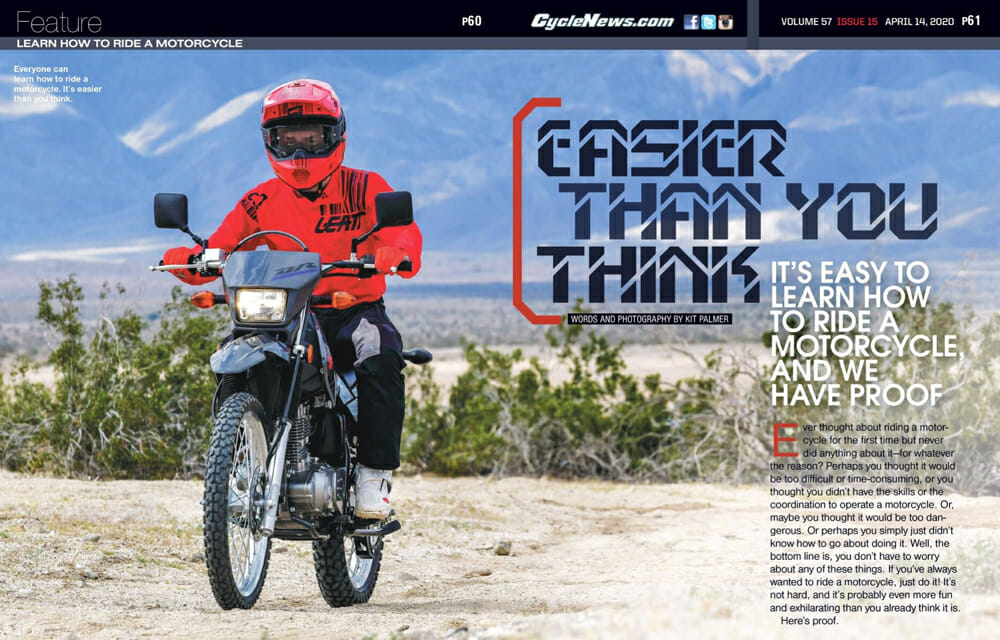Kit Palmer | April 20, 2020
It’s easy to learn how to ride a motorcycle, and we have proof.
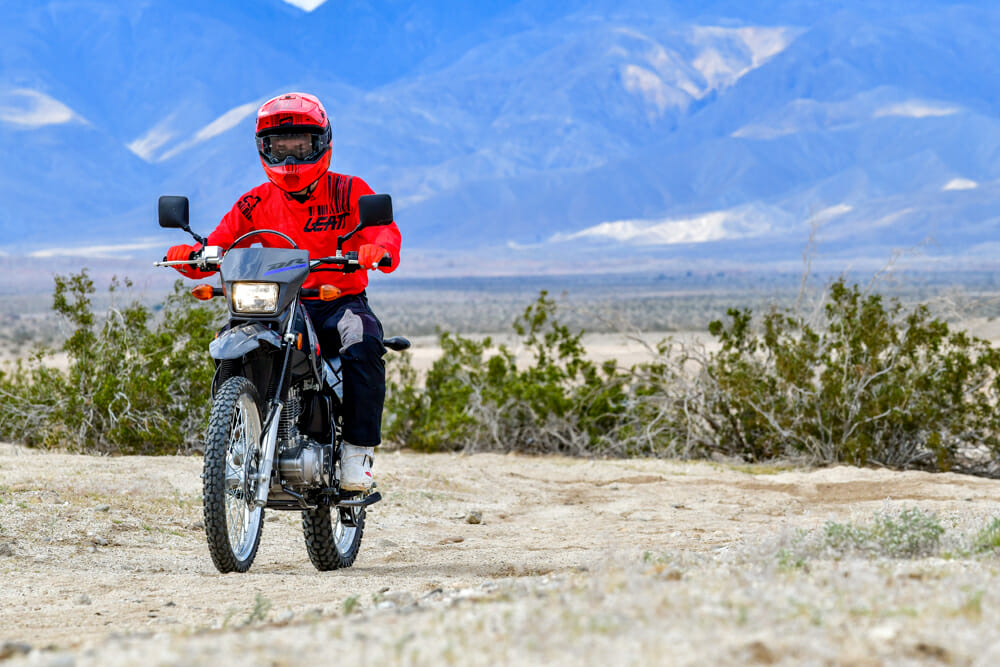 Everyone can learn how to ride a motorcycle. It’s easier than you think.
Everyone can learn how to ride a motorcycle. It’s easier than you think.
Words and Photography by Kit Palmer
Ever thought about riding a motorcycle for the first time but never did anything about it—for whatever the reason? Perhaps you thought it would be too difficult or time-consuming, or you thought you didn’t have the skills or the coordination to operate a motorcycle? Or, maybe you thought it would be too dangerous. Or perhaps you simply just didn’t know how to go about doing it? Well, the bottom line is, you don’t have to worry about any of these things. If you’ve always wanted to ride a motorcycle, just do it! It’s not hard, and it’s probably even more fun and exhilarating than you already think it is.
Here’s proof.
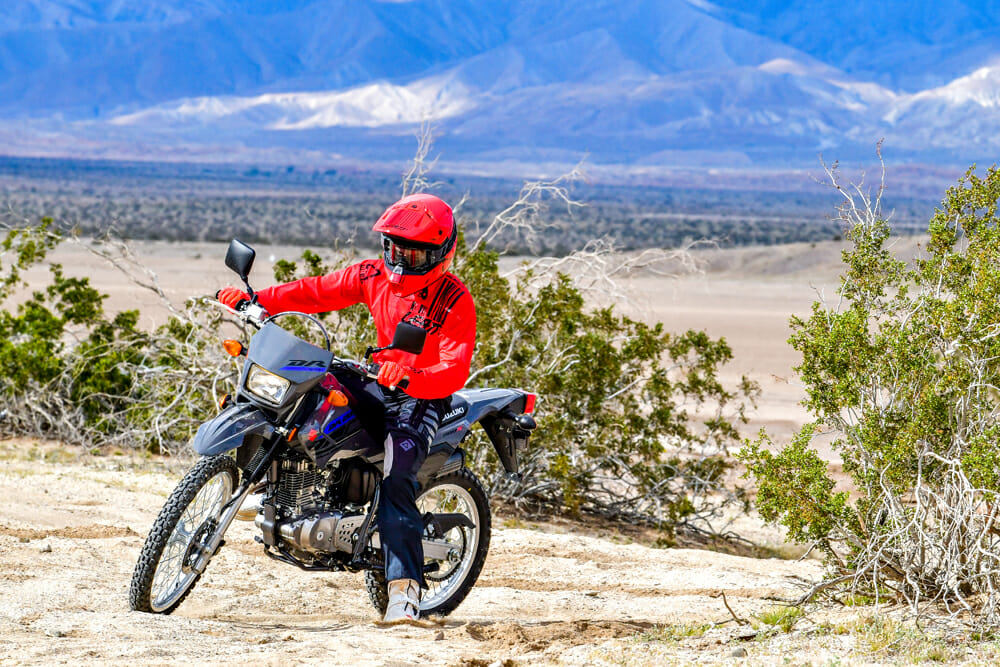 Landon spent his 17th birthday learning how to ride a motorcycle. By the end of the day, he was already out enjoying his first trail ride.
Landon spent his 17th birthday learning how to ride a motorcycle. By the end of the day, he was already out enjoying his first trail ride.
Plan B
Meet Shawna and Landon. On this particular day in March, they were supposed to be high above the clouds over the Atlantic Ocean, flying to Europe to celebrate Landon’s 17th birthday over spring break. But this trip was twofold; it was also a chance for them to spend some quality mother-and-son time before Landon shuffles off to college next year, and who knows when the both of them will have the time—at the same time—to do an adventure like this before life kicks into high gear for Landon. So, this was the ideal time for them to get away on a trip of a lifetime. Or so it seemed.
They had been planning this two-week trip—a big chunk of it to be spent in Italy—for more than a year. Instead, they found themselves on a dry lakebed on a chilly and windy day in the middle of the California desert. No, it wasn’t Rome or the hills of Tuscany; instead, it was Ocotillo Wells (SVRA). This place would have to do. As it turned out, it did—and then some—because it was on this Saturday afternoon that both Shawna and Landon learned how to ride a motorcycle.
Once it was clear that traveling to Italy was out of the question, Shawna put plan B into gear the moment after she hit the cancel button on her computer and their vacation plans, following the arrival of COVID-19. (I promise, this will be the only time you’ll see that word in this story.) Unfortunately, there was no plan B, yet there was still a birthday to celebrate, and nothing was going to alter that.
And since it was his 17th birthday, mom wanted it to be something unique and memorable, like going to Italy. A new idea was eventually hatched: teaching Landon how to ride a motorcycle on his actual birthday. He was on board with that idea! And so was Shawna. She also wanted in on the fun of throwing her leg over a motorcycle for the first time. It might not have been the mother/son activity Shawna was planning for the past year, but this was shaping up to be a pretty good last-minute alternative.
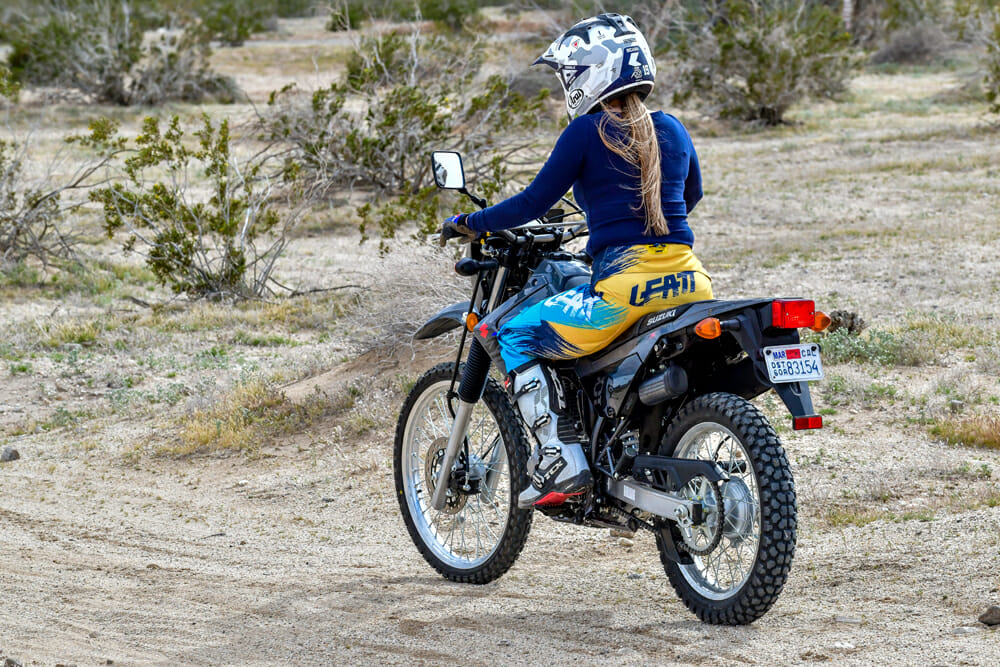 Shawna, who had never even sat on a motorcycle before but always wanted to ride one, caught on in no time.
Shawna, who had never even sat on a motorcycle before but always wanted to ride one, caught on in no time.
Luckily, I already had a motorcycle in our Cycle News arsenal that would be the perfect fit for both Landon and Shawna to learn on, a Suzuki DR200S dual sport. The DR has a low seat height, docile power and electric starting—three key ingredients in helping make teaching newbies much easier. The DR is not exactly a light motorcycle, but the low seat height helps make up for that.
Even though both are outdoorsy people, neither Landon nor Shawna are familiar with motorcycles; in fact, they’ve never really been around motorcycles. But they always wanted to ride one. After all, it looks like fun, and they are into having fun and trying new things. Landon, I thought, would be a bit of a challenge to teach since he had never before operated any kind of vehicle with a clutch or a manual transmission, but he had plenty of two-wheel experience on a bicycle. Perfect.
I’ve always felt that learning to ride a motorcycle on the dirt is best. Pavement is hard, dirt is soft, and dirt teaches you that a wiggling motorcycle on the unstable ground beneath you is not unusual or something to be afraid of. Riding on dirt quickly forces you to learn how to control the motorcycle by having to continually make corrections on the soft and irregular ground. I realize it might be a little more difficult at first, but in my mind, the learning curve is much steeper on dirt, and I believe it’s safer, as well. I taught my wife how to ride a motorcycle on the dirt, and she’s never looked back. It’s fine to get your motorcycling feet wet on the pavement, for sure, but I prefer getting started on terra firma if possible.
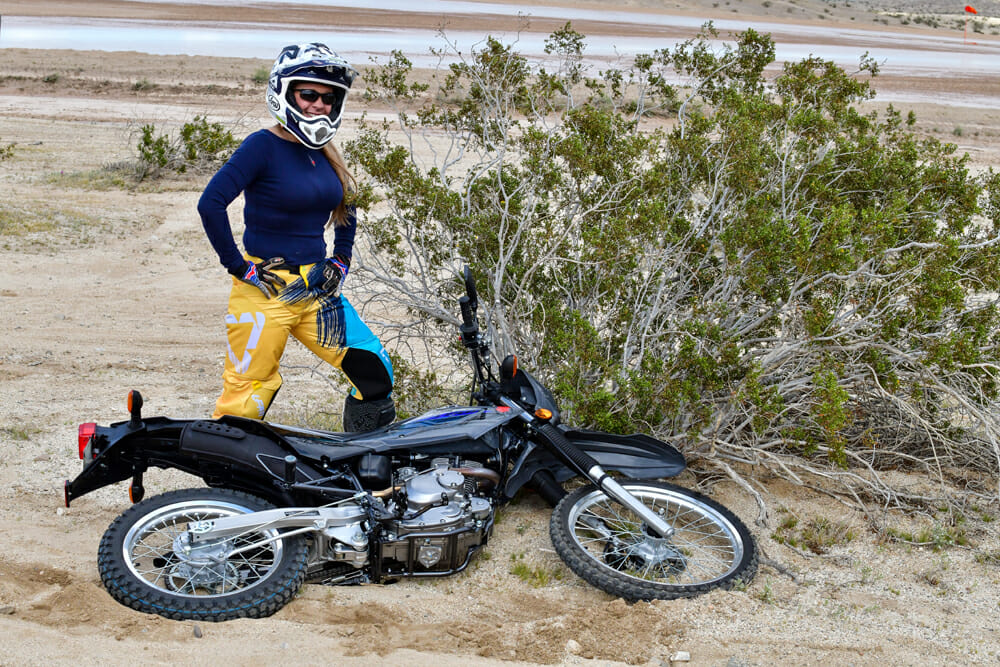 Yes, these things happen when learning, and the best way to handle it is to laugh about it, shake it off and get back on. No big deal.
Yes, these things happen when learning, and the best way to handle it is to laugh about it, shake it off and get back on. No big deal.
The Clutch
Any accomplished motorcyclist will tell you the hardest part about learning how to ride a motorcycle was mastering the clutch. Figuring out that fine line between stalling the engine and moving forward can be terrifying, done wrong, and things can get ugly quickly. I know, it happened to me. My teacher, my older brother, skipped the teaching part and just said, “go for it.” I was so anxious and excited that I just grabbed a handful of throttle, and off I went. I ended up 10 feet off the trail in the weeds only 20 yards from where I started. Luckily, the landing was soft. It could’ve been much worse, and I could’ve slammed into my neighbor’s garage door or mailbox.
Landon’s introduction to motorcycle riding was far more successful and graceful than mine. We found a flat open area in the desert, and before long, Landon was circulating our camp on the DR, while mom was chewing up megabytes on her phone’s camera recording every minute. At first, Landon went through the usual frustration and embarrassment of stalling the DR’s engine, but he soon figured out the clutch/throttle routine and was on the loose. The handlebars never touched the ground.
Now it was mom’s turn. At 5’4”, seat height, I thought, would be Shawna’s biggest obstacle, but it turned out to be a non-issue. Yes, she had to lean the bike a little bit to get solid footing, but it did not discourage or slow her down in any way.
Having had owned cars with manual transmissions, Shawna had a good understanding and feel for the DR’s clutch and, like Landon, had it mastered in no time and was soon meandering across the desert floor all by herself, on a motorcycle, with a massive smile on her face. Before long, both Landon and Shawna were shifting through the gears and enjoying their first trail ride away from camp.
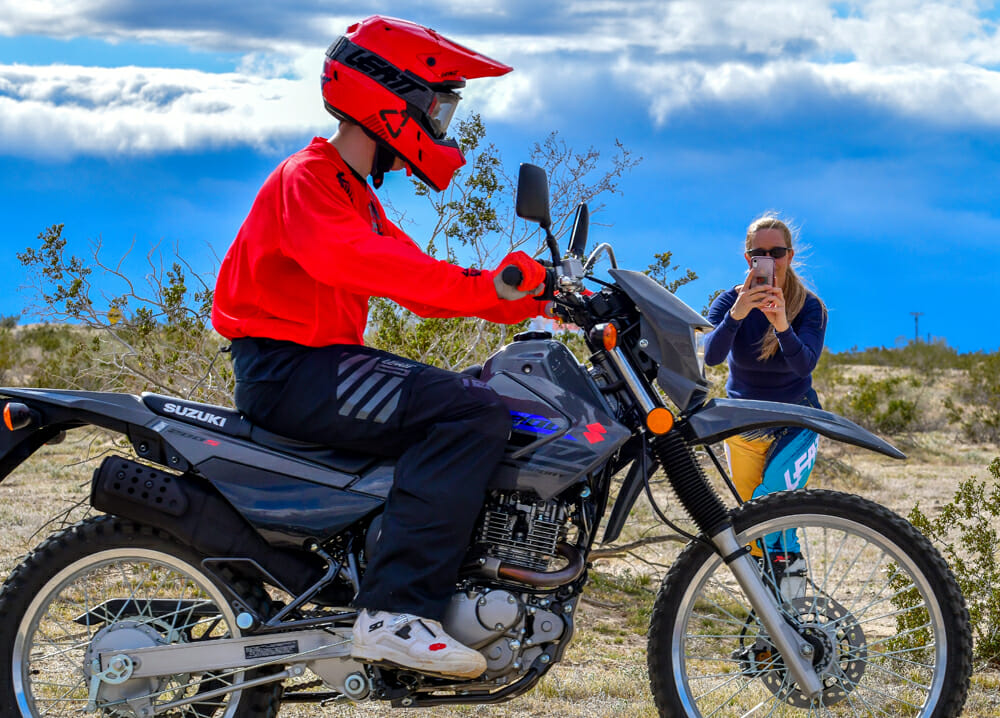 One proud mom.
One proud mom.
A Day To Remember
Okay, so this might not have been the day spent at a chateau in Tuscany Shawna and Landon had planned, but it was a day that will hopefully bring long-lasting memories for both who said they thoroughly enjoyed their first experience riding a motorcycle and want to do it again—soon.
“Having been given the opportunity to ride a dirt bike for the first time was exhilarating,” said Shawna. “There was a learning curve, but once I learned to trust the bike the way it was built to perform, I quickly realized that it was easier than anticipated, and any nerves that I had about it were quickly replaced with pure joy and excitement.
“My favorite part was the feeling of being free on the bike,” Shawna said. “I thoroughly enjoyed the feeling of riding something powerful, feeling the wind on my face and conquering the challenges, and the euphoria that came from discovering I was successful at it. I’m pretty sure I had a giant smile on my face the entire time.” (Yes, she did.)
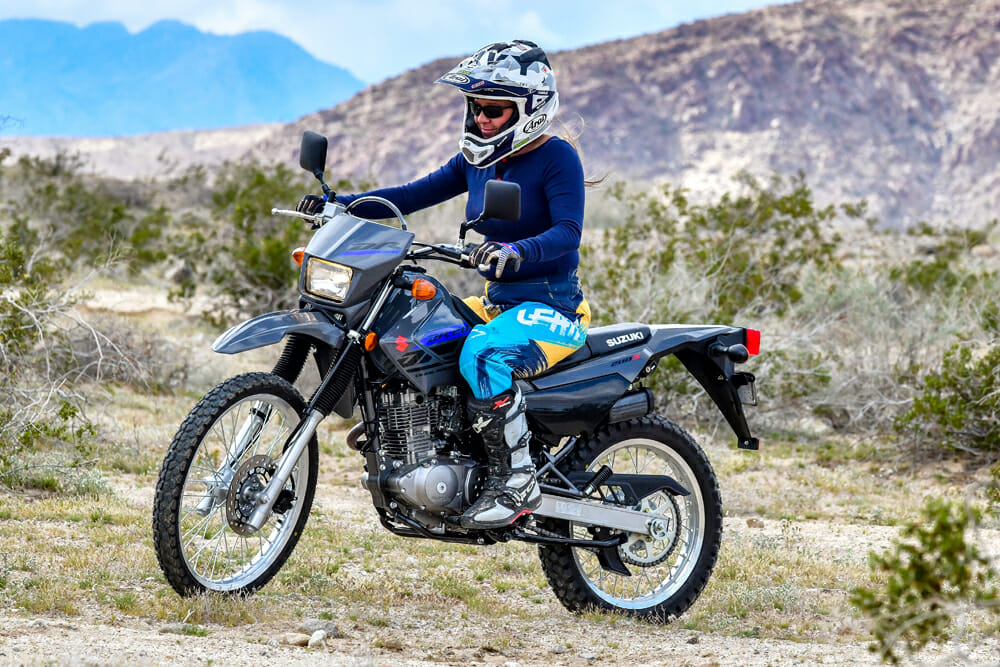 That smile was genuine and never went away.
That smile was genuine and never went away.
“And watching my son’s pure joy in navigating the bike and seeing him love every moment was such a special treat. It was a very exhilarating day riding dirt bikes, and I simply cannot wait for the next adventure on them.”
Landon got straight to the point: “It was cool!” And, like Shawna, he agreed that learning to ride a motorcycle was no big deal and nothing to be afraid of. “It was a lot easier than I thought it would be,” Landon said. “I thought shifting gears was the most fun and, well, just going fast!”
Welcome to the club, Shawna and Landon.
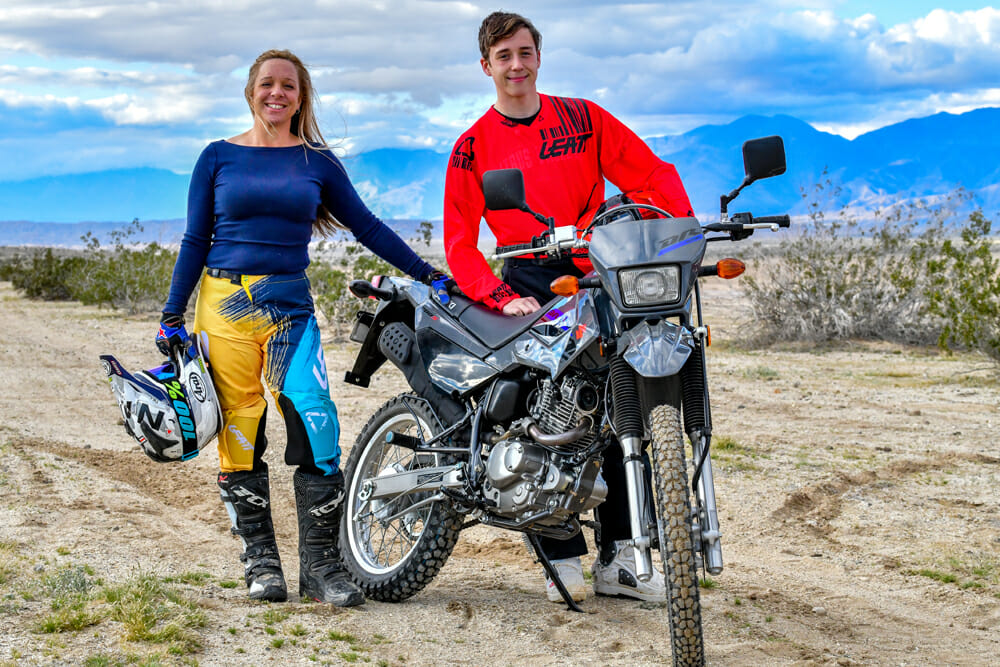 Both mom and son got to share the experience of learning how to ride a motorcycle.
Both mom and son got to share the experience of learning how to ride a motorcycle.
Lucky for them, they are friends with someone in the motorcycle industry who had the means to help them bring one of their dreams come to fruition, but there are many organizations out there who are far more qualified than my well-meaning brother and me to teach you how to ride a motorcycle. The Motorcycle Safety Foundation (MSF) quickly comes to mind, and they have training centers all over the country, and if you happen to live in Southern California, the Honda Training Center in Colton, California, is a great choice, as well.
Don’t wait. If you’re thinking about learning how to ride a motorcycle, a good time to do it is, well, now. It’s not hard, it doesn’t take a lot of time, and you’ll be glad you did. Just ask Shawna and Landon.
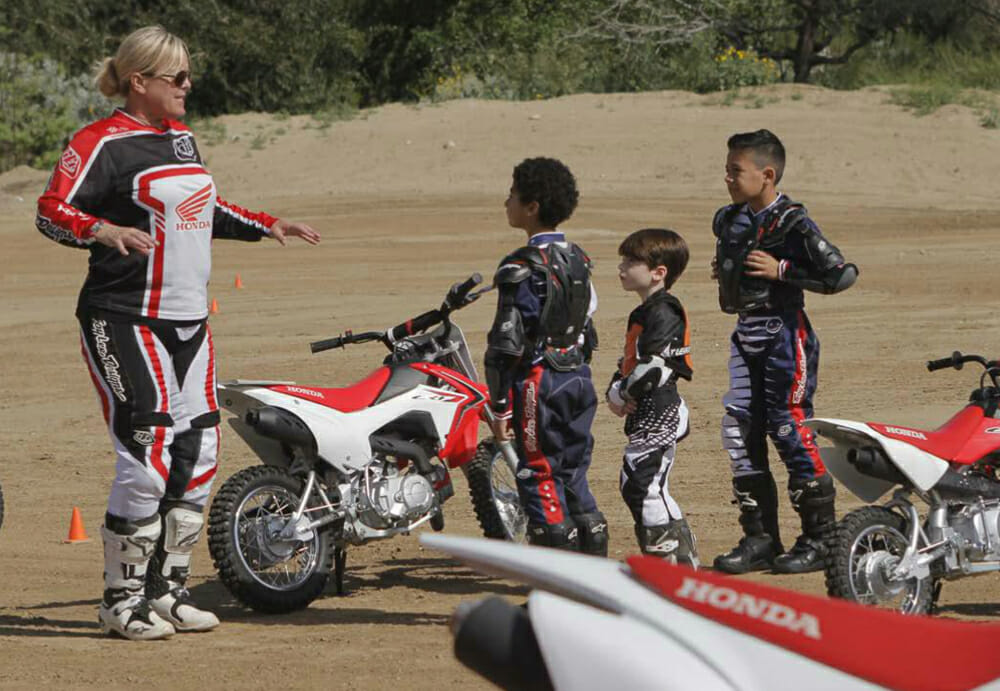 There are many certified organizations out there that will love to teach you, your kids, your mother or whoever how to ride a motorcycle.
There are many certified organizations out there that will love to teach you, your kids, your mother or whoever how to ride a motorcycle.
How To Get Started
All states now require the Class M endorsement on a license to operate a motorcycle on public roads legally. The entity in charge of the motorcycle-training courses varies from state to state, as do the prices (in Illinois, for example, the basic course is free!). But many of them are using, as mentioned, the Motorcycle Safety Foundation (MSF) courses, including Honda’s Colton Rider Education Center (RECs) in California, which was one of the very first motorcycle-training centers in the U.S. that was open to the public. Soon after the California Rider Education Center was established, three more were opened in Irving, Texas; Alpharetta, Georgia; and Troy, Ohio. The Honda RECs were the first of their kind to be built by an OEM, with dedicated classrooms and ranges for teaching street, ATV and off-road riding skills. Police and military agencies also use the facilities for their own specialized rider training programs.
Harley-Davidson has its Riding Academy New Rider Course at authorized H-D dealerships all over the USA, and usually the dealer offers generous financial incentives on bikes and gear for students completing the course.
Some states run their own unique motorcycle programs, such as Team Oregon or Idaho STAR and a growing number of states are using the Total Control Clinic curriculum by Lee Parks (currently California, Colorado, Pennsylvania, Texas and, coming soon, Arizona.)
The United States Motorcycle Coaching Association (USMCA) has a certification process for coaches and riders can connect with those coaches via the motorcyclecoaching.org.
To find the nearest training center, visit your state’s DMV website, which will have links to its official motorcycle-endorsement training courses. Or you can call the MSF and plug your zip code into the hotline at (800) 446-9227 to find a nearby MSF course.
2020 Suzuki DR200S | Learning Tool
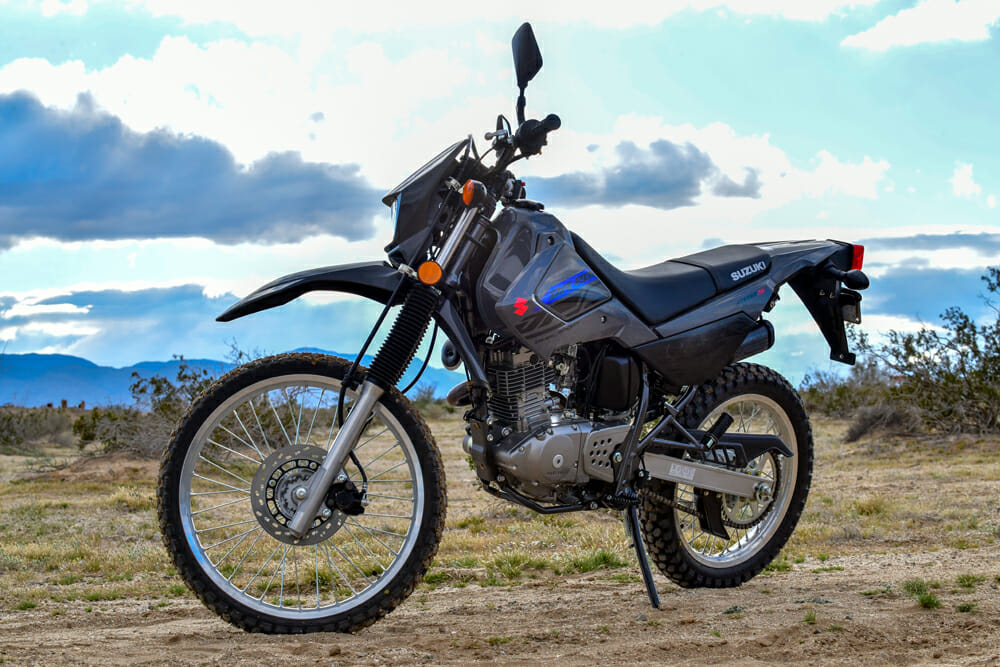
The history of the DR200R dates back to the mid-1990s. It started life as the DR200SE, then Suzuki dropped the “E” in 2013 when it received a few minor changes and returned as the DR200S. It’s still the same motorcycle today.
“Simple” best describes the DR200S, a straight-forward, easy-to-ride, and reliable dual-sport motorcycle whose roots run deep in the dirt. It’s also inexpensive at $4,649 MSRP. The license plate on the back gives the DR200S far more versatility compared to a dedicated dirt bike, but this motorcycle is more at home on the trail than it is on the boulevard, but it is quite capable at both.
The DR’s engine doesn’t get much more straightforward. It’s powered by a carbureted 199cc air-cooled two-valve SOHC engine. Transmission is a five-speed, and starting is electric.
The suspension isn’t flashy, but it does sport more than eight inches of wheel travel at both ends, and the single rear shock, which offers spring preload adjustability, rides on a linkage system. The fork is non-adjustable. Ground clearance is a generous 10 inches.
The DR has a disc brake up front and a drum in the back, which is sufficient for this style motorcycle. It rolls on full-size 21-inch (front) and 18-inch (rear) wheels, fitted with IRC Trail Wing rubber. It has a somewhat low 33-inch seat height and weighs 278 curb pounds (according to Suzuki’s scale).
There are many things to like about the DR200S. As mentioned, it’s street-legal, sits low to the ground, is super-easy to ride, performs well on the dirt, and is the ideal motorcycle to learn on. The more experienced or veteran rider who has no interest in getting anywhere in a hurry will like the DR’s simplicity, reliability, and generous 3.3-gallon fuel tank, which should provide a range of more than 200 get-out-of-town stress-free miles!
Suspension is plenty good for casual trail rides, and, overall, the DR handles well and is narrow between your legs, making it feel more agile than it already is. The DR is a decent around-town commuter, but save the freeways jaunts for the DR400S.
Our only real nitpick is carburetion. The 31mm Mikuni BST carburetor actually works well at temperature but coughs and blubbers seemingly forever before getting there, and if it sits too long in the garage between rides, the pilot jets will clog. Carburetion is not a game-changer, but EFI would be nicer.
Overall, we still love this bike. There’s a reason why the DR200S has been in Suzuki’s lineup for more than 20 years—it’s practical, inexpensive, and it does what it’s intended to do very well. It’s also a fun, reliable, and easy-to-ride dirt bike that doubles as an excellent light-duty commuter. And all for under five grand brand new. CN
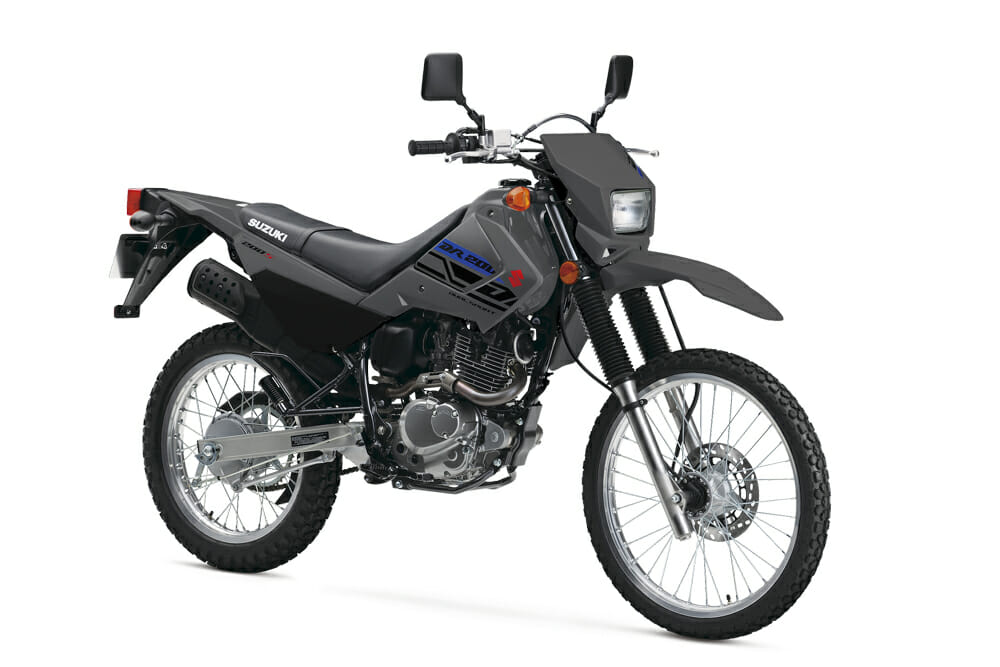
2020 Suzuki DR200S Specifications
|
|
| MSRP: |
$4,649 |
| ENGINE: |
Air-cooled, 4-stroke, SOHC, 2-valve single |
| DISPLACEMENT: |
199cc |
| BORE X STROKE: |
66 X 58.2mm |
| COMPRESSION RATIO: |
9.4:1 |
| FUEL SYSTEM: |
Mikuni BST31SS carburetor |
| IGNITION: |
Electronic CDI |
| HEADLIGHT: |
12V 60/55W (H4) |
| TAIL LIGHT: |
12V 21/5W |
| STARTING: |
Electric |
| LUBRICATION: |
Wet sump |
| TRANSMISSION: |
5-speed |
| CLUTCH: |
Wet, multi-plate |
| FINAL DRIVE: |
#520 chain |
| FRONT SUSPENSION: |
Telescopic, coil-spring, oil-damped, non-adjustable |
| REAR SUSPENSION: |
Single shock, link-type, coil-spring, oil-damped, preload-adjustable |
| FRONT-WHEEL TRAVEL: |
8.1 in. |
| REAR-WHEEL TRAVEL: |
8.1 in. |
| FRONT BRAKE: |
Single disc |
| REAR BRAKE: |
Single drum |
| FRONT TIRE: |
70/100-21 IRC Trail Wing |
| REAR TIRE: |
100/90-18 IRC Trail Wing |
| O/A LENGTH: |
84.8 in. |
| O/A WIDTH: |
31.7 in. |
| O/A HEIGHT: |
44.9 in. |
| WHEELBASE: |
55.3 in. |
| GROUND CLEARANCE: |
10 in. |
| SEAT HEIGHT: |
33.3 in. |
| WEIGHT (CURB, CLAIMED): |
278 lbs. |
| FUEL CAPACITY: |
3.3 gal. |
| FUEL ECONOMY (CLAIMED): |
88 mpg |
| COLOR: |
Iron Gray |
